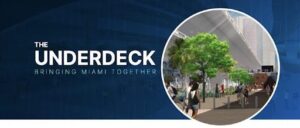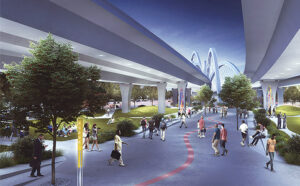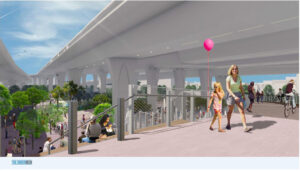Samantha Morell Miami Times Staff Writer May 17, 2022 Updated Dec 5, 2022
Five years after the state accepted plans for an enhanced I-395 and a signature bridge to go with it, a team of local Black architects is left wondering if its design for a cultural public space underneath the reconstructed highway will ever see the light of day.
Ron Frazier, Neil Hall and Zamarr Brown were among the lead architects – alongside urban planning team PlusUrbia – responsible for coming up with “Heritage Trail,” an area of recreation meant to connect Overtown with Biscayne Bay and propel Miami’s diverse history into the Magic City spotlight. The plan was proposed as part of a joint venture between engineering groups Archer Western and de Moya, which are now leading the ongoing construction of their I-395/SR 836/I-95 design-build project.
When the joint venture’s proposal was first chosen by the Florida Department of Transportation (FDOT) in 2017, the team of architects was under the impression that Heritage Trail would be built once the highway was completed. It wasn’t until talk of what’s now known as The Underdeck began to spread that the existence of a new plan for the public space was made clear.
“There were at least three years in which we didn’t hear anything from anybody, and all of a sudden we saw that the city was moving ahead with someone to create a new plan, so we were left out in the dark in terms of that,” Frazier said.
Localization of power
Soon after construction on the highway began in 2019, FDOT delegated some of the planning power to the city of Miami, which the department felt was a better fit to operate a local space. That’s when Frazier says he stopped receiving updates.
He initially thought that the move to localize efforts would only foster a plan for maintaining the space once it was constructed, essentially building upon the design Frazier and his colleagues had already envisioned. But according to the first memorandum of understanding (MOU) detailing the partnership between FDOT and Miami, the city was to submit a new plan “with a level of specificity comparable to the plan and design” originally submitted through the joint venture.
That MOU was made effective April 4, 2019, about three months after Archer Western and de Moya broke ground on the highway. In December 2021, the city entered into yet another MOU with the Town Square Neighborhood Development Corporation, a nonprofit organization that oversees development surrounding the Adrienne Arsht Center for the Performing Arts and would house the dollars allocated to fund the new engagement process.
As a result of that MOU, a committee composed of local leaders, residents and advocates was tasked with engaging the public for input. The Underdeck committee – officially called The Underdeck Subcommittee Advisory Board (USAG) – has since begun to host monthly community meetings to facilitate that engagement.
“It was like everybody was starting from ground zero and asking people what did they want and the whole bit,” said Frazier. “Well, we already did that.”
A game of numbers and names

The committee has since released a design plan finalized by architectural firm Hargreaves Jones, including water features, open lawns and community plazas. What it doesn’t share with the original plan, however, is specific references to the legacies of Caribbean and Native American cultures woven throughout the fabric of Miami’s history.
“[The Heritage Trail] was looking at it from a time machine more or less,” said Frazier. “Starting in front of the Arsht theater would be that area where the Tequesta Indians were settled, and as you move toward the Miami River, it would sort of tell the story of how Miami was born.”
Lisa Martinez, the lead facilitator for the USAG, assures that the committee is determined to reach a consensus plan that is just as diverse as the people whose communities it will affect. Every month a meeting is held in Overtown and another in the Biscayne corridor, to make sure all residents have a chance to be heard.
“Development of diverse representation and inclusion is at the heart of The Underdeck Committee and TSNDC’s work,” she said, which includes collaborating with small and minority-owned businesses.

But everything is tentative until prices are itemized and numbers drawn. A particular goal of the committee is to evaluate a cost for the new plan – and to see how it weighs next to that of Heritage Trail.
An update on finances was initially promised for the monthly meetings in April, during which Martinez instead announced that the process had been indefinitely delayed – as had the construction of the signature bridge itself. The completion of the highway has since been rescheduled for the summer of 2026, nearly two years later than its original target date.
Still, the issue that seems to be on everyone’s mind has less to do with costs and more to do with names. Heritage Trail is one of 15 names so far proposed by The Underdeck committee, with others ranging from “Towners Mile” to “Legends Place” and more.

Many Overtown residents feel that the official name should include a direct reference to their neighborhood, which was torn apart by the original construction of the I-95 highway in the 1960s. Others want to make sure that The Underdeck’s branding is equally reflective of every community it passes through.
In any case, the original name, Heritage Trail, will be reserved in the new design – if not for the entire public space, then at least as the designation for a walkway connecting its east and west ends.
Earlier this year, the USAG conducted an initial survey to allow residents and stakeholders to vote on a name or to propose their own. A follow-up survey is expected to be released soon.
The next Overtown community meeting is scheduled for 6 p.m. on May 31 at the Urban, located at 1000 NW Second Ave. Doors open at 5 p.m.
A winding road ahead
Whatever the committee comes up with – from names to funding strategies to design content – has to be reviewed by the city before the consensus plan can move on back to FDOT for final approval. In the end, both the state and the city have to execute a lease agreement in order to clear the way for proper ownership and zoning changes.
There is a possibility that the state will retain the services of the original team of Black architects responsible for Heritage Trail, but Frazier and Hall have all but given up hope on that front. Frazier, who has been an urban planner for six decades, says he’s all too familiar with the destruction that highways bring to minority communities.
“The same thing is going to happen to Overtown that’s always happened to Overtown and all the other Black communities that these interstate highways and other stuff are going through: It’s just going to become a thing of the past, and nobody is ever going to remember what happened in that area,” he said.
Hall believes the city should be the one to engage the original team of architects rather than continuing to pay another firm to work on a new design.
Miami City Manager Arthur Noriega did not respond to The Miami Times for comment by press time.
And as bridge construction treads on – which Hall believes is the only priority for FDOT, Archer Western and de Moya – he fears the state will end up signing off on a design that’s nothing more than “vanilla.”
“This is a big deal, and if we are not participating at the level of the Adrienne Arsht Center group, the Midtown group and also the Wynwood group, then we’re playing checkers while they’re playing chess, and I am tired of it,” he said.
“All you have to do is walk down there underneath that [highway] and ask the question, who owns all the property adjacent to this expressway?” Frazier said. “And then you ask yourself, who is this space going to be for? And when they say it’s for the residents of Overtown, which residents? Is it those that are there now that won’t be there, or those that will be living in all those high-rise buildings looking down on that space?”






